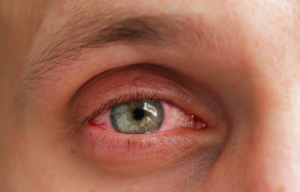What’s Causing My Eye Allergies, and What Can I Do About It?

Allergy is an overreaction of your normal immune system—typically to something in your environment. Allergy can vary from minor itchiness to life-threatening anaphylaxis and death. Most allergies are not severe, but can be a major annoyance in our lives. Eye allergies take a number of forms with the most common being allergic conjunctivitis.
Allergic Conjunctivitis
The conjunctiva is the clear membrane that covers the white part of the eye and the inner eyelids. This tissue has a very good blood supply and specific cells that can respond to various types of injury and allergy. These cells release chemicals when stimulated by pollen, dust, pet dander, mold or any other thing in the environment that you have become allergic to. These chemical mediators like histamine cause the allergic response that we all know as itchy, watery, irritated, red eyes. The response can be severe enough that the clear conjunctiva swells with fluid and seems to bulge out from the eye. Eyelid swelling is not uncommon with an allergic response, as well. The swelling is caused by these chemical mediators acting on the blood vessels, causing them to expand and leak fluid into the tissue.
There are a number of things that can be done to treat eye allergies. Cold compresses made by wrapping a thin damp cloth around a bag of frozen peas or corn and applied to the closed eyes work very well in helping to reduce the swelling and ease the itching of allergies. The cold helps to constrict the blood vessels so less fluid can leak out into the loose eye and eyelid tissue. Anti-allergy eye drops can help to reduce the symptoms as well. There are a number of over-the-counter eye drops for allergies. These tend to help reduce the itchiness, redness and irritation that allergy sufferers experience. Ketotifen eye drops (also sometimes labeled as Alaway or Zaditor) work very well for allergies. It’s best to avoid some of the older allergy eye drops such as Visine, Murine, Opcon, and Naphcon as they have a tendency to dry the eyes further and can even cause an increase in the redness after the drop wears off. If the over-the-counter drops don’t work for you, come see one of our doctors—there are prescription strength anti-allergy drops that tend to work much better, and we can prescribe one for you, if needed.
Even though your eyes may be very watery, the surface of the eye can become dry and irritated. Artificial tear eye drops can help to relieve some of the irritation symptoms and help the surface of the eye to heal. Try not to use any eye drop that says it “gets the red out,” as they can dry the eye even more. Common artificial tears are: Refresh, Systane, Thera Tears, and Tears Naturale.
Allergy pills taken by mouth can also help to relieve some of the eye symptoms of allergies. There are a number of over-the-counter allergy pills that tend to work very well such as: Zyrtec, Claritin, Allegra, and the newest one: Xyzal. Many of these come in two forms; either just the medicine for allergy (e.g., Claritin) or combined with a decongestant such as pseudoephedrine. The ones with a decongestant will have a “D” following the name (e.g., Claritin D). The decongestant may help to reduce a stuffy nose, but can dry the eyes out significantly, so it’s best to avoid those if possible.
Contact Dermatitis
Another type of allergy that can affect the eye and eyelid is contact dermatitis. This is an allergy to something that is contacting the eyelid or eye, such as an eye drop or makeup product that you have become allergic to. There are many things that can cause a contact dermatitis and often the search for what is causing it is long and nearly impossible. This allergy tends to build up slowly over weeks with gradual worsening of eye and eyelid itchiness and redness. It often presents with “raccoon eyes”: redness, swelling, and darkening of the skin around one or both eyes. One of the hallmark symptoms of contact dermatitis is intense itching of the eyelids with eyelid skin that is dry and rough.
Contact dermatitis is treated by identifying the inciting product and removing it from contact with the eye or eyelid. Some steroid eye drops and allergy drops can often help, as well as steroid cream for the eyelids. Never use steroid cream around the eyes without the consent and advice of your eye doctor, as there are numerous risks if used improperly such as increased risk of infection and glaucoma.
Most allergies are seasonal, due to pollens in the air, but many times they can last year-round if your allergy is caused by dust, mold, pet dander, or other things you are exposed to on a regular basis. The best treatment for allergy is to avoid what you are allergic to if at all possible. Although that’s difficult to do all the time, if allergy flares up, know that there are things that can be done to help alleviate the suffering.
If you have concerns about your allergies or want to learn more about what you can do to reduce redness and itchiness, please contact us today to schedule a consultation with one of our eye doctors.
